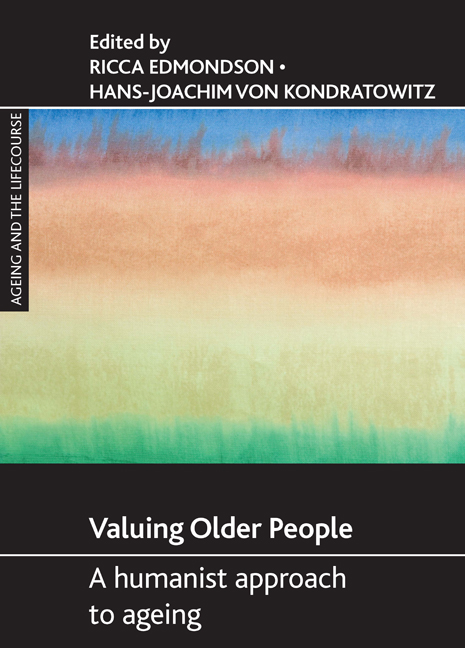Book contents
- Frontmatter
- Contents
- List of tables and figures
- Notes on contributors
- Acknowledgements
- Foreword
- Introduction
- Part One Religion, spirituality, cultural resources and creating meaning
- Part Two Norms, values and gerontology
- Part Three Ageing and wisdom? Conflicts and contested developments
- Afterwords
- Index
- Available titles in the Ageing and the Lifecourse series
sixteen - Exploring positive images of ageing: the production of calendars
Published online by Cambridge University Press: 05 July 2022
- Frontmatter
- Contents
- List of tables and figures
- Notes on contributors
- Acknowledgements
- Foreword
- Introduction
- Part One Religion, spirituality, cultural resources and creating meaning
- Part Two Norms, values and gerontology
- Part Three Ageing and wisdom? Conflicts and contested developments
- Afterwords
- Index
- Available titles in the Ageing and the Lifecourse series
Summary
Introduction
This volume deals with a variety of ways in which ageing can be understood and older people responded to. We have seen that a humanistic approach to gerontology embraces a genuine multidisciplinarity that combines contributions from a variety of standpoints and disciplines – and attempts to deal with some of the real questions as well as the richness that this variety represents.
In this connection there is a growing interest in, and an accumulating corpus of knowledge on, visual representations of ageing, which reflect precisely this twosidedness with which gerontology must deal. Visual images are extraordinarily powerful, but also extraordinarily ambiguous, and interpreting them underlines the need for gerontology to confront profound ethical and political questions. We can take as an example here images of ageing in photography. For instance, Blaikie (1994, 1995) has examined photographs as a means of exploring how they represent memory through a focus on generational relationships. Featherstone and Hepworth's (1995) focus on photographic images in retirement magazines resulted in their identification of midlife as a new stage of the life course. Similarly, Blaikie and Hepworth (1997) showed how contemporary photographs convey meanings of ageing. Clearly, some of these imputed meanings may require criticism, not only celebration. Different kinds of care relationships depicted in photographs have been the concern of Johnson and Bytheway (1997). At the same time there has been an emphasis, especially by policy makers, on positive ageing. Images abound of examples of older people ‘doing’ positive ageing – however questionable some notions of positive ageing may be. An alternative view is offered by those who examine images to allow the ‘deconstruction of the image of old age as a necessary phase of bodily decline’ (Featherstone and Wernick, 1995: 6). This contribution, too, concentrates on images of positive ageing but, unlike previous studies, examines photographs in calendars that were explicitly produced as part of a ‘positive images of ageing’ campaign. Photographic images presented here, then, were not retrieved from a picture library, nor were they derived from photographic exhibitions or previously published books of photographs. Images offered here were designed to support older people, as part of a campaign, which, like this book, was called Valuing Older People.
- Type
- Chapter
- Information
- Valuing Older PeopleA Humanist Approach to Ageing, pp. 277 - 282Publisher: Bristol University PressPrint publication year: 2009

